Are you a Quiet Speculation member?
If not, now is a perfect time to join up! Our powerful tools, breaking-news analysis, and exclusive Discord channel will make sure you stay up to date and ahead of the curve.
Sideboarding is a skill-intensive and essential component of competitive Magic. While it isn't an "Easy to learn, hard to master" skill, it feels very close. Sideboarding guides can be useful to overcome this learning curve, but they can also become a crutch and actively harmful to your chances of improving. Last week I went over the basics of the Modern sideboard. This week I'm going to follow up with more advanced strategies.

The strategy I advocated last week involved packing your sideboard with "silver bullets," cards that win the game unaided against certain decks. As a competitive player I cannot fathom why you wouldn't use as many as you can since they're free wins, but it isn't always possible. Some decks have no bullets for you to use or the colors you're playing don't support effective ones. There really isn't a silver bullet to beat Jund, for example (though Blood Moon comes close). This normally means that your only option is the Standard-style adjustment, bringing in cards that adjust the matchup rather than win it or dramatically alter things. While it might feel like this is the only option, that isn't true. If you're willing to commit to it, you can dramatically alter post-board games with a transformational sideboard, or try to pre-board against certain matchups.
[wp_ad_camp_1]
Transform and Dodge Hate
The idea of the transformational sideboard has been around for quite some time, but it isn't very popular. Sheridan mentioned it a few months ago in regards to Affinity bringing in Ghirapur Aether Grid and Ensnaring Bridge against Eldrazi, and also gave some pretty good reasons why you should stay away. However, while for many decks there isn't any point, there are other times when this strategy works. Let's investigate the latter.
When most players think of transformational sideboards I suspect that they are thinking of Terry Soh's Tooth and Nail deck from his Invitational win. For reference:
"Tooth and Nail, Terry Soh (2005 Invitational)"
Tooth and Nail was an incredibly powerful deck, but it was quite vulnerable to hate such as Sowing Salt, Bribery, and Cranial Extraction. The typical plan for the deck was to ramp up to an entwined Tooth and Nail, for Darksteel Colossus and Kiki-Jiki, Mirror Breaker to 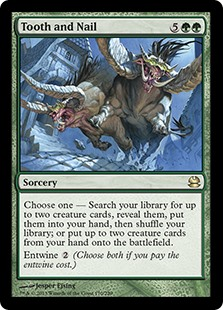 just win or Mephidross Vampire and Triskelion to clear the board of creatures. Removing a key creature or the namesake sorcery from the deck often left TnN unable to win.
just win or Mephidross Vampire and Triskelion to clear the board of creatures. Removing a key creature or the namesake sorcery from the deck often left TnN unable to win.
Prior to Soh's Invitational win the trend had been to replace the combo pieces with more easily castable creatures that didn't immediately kill you if they got stolen. Soh took it to the logical limit by removing the TnN package entirely in games 2-3, turning his deck into a midrange beatdown deck in the style of Jamie Wakefield. The advantage was that he was now effectively invulnerable to the common TnN hate and the opponent was suddenly left with dead cards in their deck. This repositioning won Soh the Invitational and subsequently became the norm for TnN players for the remainder of its Standard life.
This is ultimately the problem with transformational sideboards and why you don't see them very often. Players were adopting the sideboard plan without really thinking about why and as a result TnN's power and metagame position began to decline. The transformation 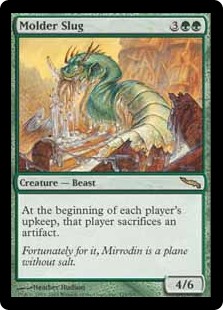 worked for Terry Soh because he was going to a relatively small tournament and he could metagame against the other players, most of whom had slower control decks, and take them by surprise. Once the strategy was known it was far less effective---the common sideboard cards were abandoned for more general answers to creatures, and the TnN players often hurt themselves by adopting the plan.
worked for Terry Soh because he was going to a relatively small tournament and he could metagame against the other players, most of whom had slower control decks, and take them by surprise. Once the strategy was known it was far less effective---the common sideboard cards were abandoned for more general answers to creatures, and the TnN players often hurt themselves by adopting the plan.
At 2005 Regionals I played White Weenie and I knew going in that TnN was a really bad matchup. I had to race their mana ramp or I just lost to the Mephitrike combo, with my only out being triple Awe Strike. Thanks to Terry Soh I didn't end up dropping a match to TnN because his strategy had been so widely adopted that players didn't have Mephitrike anymore and those who did sided it out against me for the transformation. Transforming works when you dodge crippling hate, but if you do it for no reason then you weaken your deck.
When to Transform
 If you are going to have a transformational sideboard you need to commit to it. Twelve of Soh's sideboard cards are directly part of his plan, and Plow Under arguably qualifies as well. Even later in the season when the strategy fell out of favor, Soh was still playing seven beatsticks in his board. What this means is that you need to be certain that you will need to transform almost every game and that the opponent will fall for the change. It's very much a glass cannon strategy since it relies on your opponent dancing to your tune games 2-3. If they don't fall for it, you've made your deck worse for no reason and will lose.
If you are going to have a transformational sideboard you need to commit to it. Twelve of Soh's sideboard cards are directly part of his plan, and Plow Under arguably qualifies as well. Even later in the season when the strategy fell out of favor, Soh was still playing seven beatsticks in his board. What this means is that you need to be certain that you will need to transform almost every game and that the opponent will fall for the change. It's very much a glass cannon strategy since it relies on your opponent dancing to your tune games 2-3. If they don't fall for it, you've made your deck worse for no reason and will lose.
Following the Invitational many control players adjusted to Soh's plan by keeping their sweepers post-board, where normally they were useless against Darksteel Colossus, and turning the matchup around completely. To avoid this type of pitfall, I have some rules for transforming:
1. Only transform your win condition.
If sideboard hate cards beat your specific win condition but not your strategy on the whole then a transformation is appropriate. In the Soh example Sowing Salt stalled the fast-ramp-into-fatties plan that made TnN a powerhouse but does nothing when you're just fetching basics to power out big beaters. The underlying ramp plan was still good even if it wasn't doing the most powerful thing possible anymore. Bribery was great against a small number of win conditions but worthless when you play many. You don't have enough space to completely change your deck, but you can change how it wins.
2. Only transform if you're not conceding other matchups.
Again from the Soh example, the transformation was great against Big Red, Mono-U Control, and Gifts Control, but worthless against White Weenie, a deck which saw a lot of play that Regionals. If you're certain that you'll be seeing a relatively small number of decks that attack your deck in a similar way then transforming is very effective. If it's more open then you need to be certain that your maindeck can carry you through the whole match since you won't have sideboard slots available to prepare for other decks.
3. Only transform if it complements your core.
If you're trying to completely reposition your deck through a transformation then you're likely to fail. The decks that can transform cleanly from combo to aggro or control are rare. You  have to dedicate too much space to your core strategy to make it work and frequently that means that you don't have enough room to take out all these core elements for another style's core. It's possible to assume a controlling role in a matchup, but what I'm referring to is actually changing your deck entirely.
have to dedicate too much space to your core strategy to make it work and frequently that means that you don't have enough room to take out all these core elements for another style's core. It's possible to assume a controlling role in a matchup, but what I'm referring to is actually changing your deck entirely.
For example, I've seen Storm decks with transformations into Blue Moon fail because Storm's low land count and high fluff content doesn't play well with Blue Moon's answer-heavy plan and higher average mana cost. There just isn't enough space to bring in the answer density of Blue Moon and its win conditions. Conversely those decks that turn into UR Delver are far more successful because Delver of Secrets and Young Pyromancer like low land counts and lots of cantrips. Your maindeck plan was good, so you really don't want to completely abandon it.
Transforming Modern
The most successful transformation plan in Modern has been Amulet Bloom removing Hive Mind and some of its engine pieces for green creatures. The general plan of ramping your  mana and tutoring for bombs stayed intact but didn't fail to Ghost Quarter or Slaughter Games. Combo decks in general have an easier time going for the transformation and more reason to do so. There's no reason to dramatically change Infect or Burn, nor is there enough space to do so. But Scapeshift is already pretty controlling and can take out the namesake combo for more control cards to make itself less vulnerable to Crumble to Dust and Aven Mindcensor.
mana and tutoring for bombs stayed intact but didn't fail to Ghost Quarter or Slaughter Games. Combo decks in general have an easier time going for the transformation and more reason to do so. There's no reason to dramatically change Infect or Burn, nor is there enough space to do so. But Scapeshift is already pretty controlling and can take out the namesake combo for more control cards to make itself less vulnerable to Crumble to Dust and Aven Mindcensor.
On the other hand, Modern is so diverse that the actual utility of transforming may be quite low since the actual likelihood of hitting the hate you're trying to dodge is low. In other words, don't transform unless you must.
Preboarding
Preboarding is just what it sounds like, coming into a matchup with the sideboard cards you want for that matchup maindecked. I'm not talking about having some common sideboard cards in your starting 60---that's something else. I'm talking about having your starting configuration look exactly like how you would want your deck in games 2-3 against a specific matchup.
It's not just that you wouldn't change your maindeck, it's that you specifically included cards that beat a certain deck and not others. This would be Jund packing 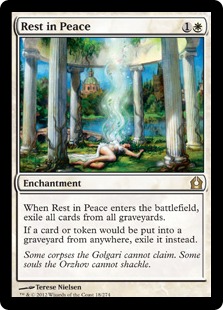 Ancient Grudge and Shatterstorm maindeck for Lantern Control and Affinity, or Death and Taxes with Rest in Peace and Spirit of the Labyrinth against UR Treasure Cruise Delver (which I'm guilty of). You almost never see this happen because players understand the rule regarding preboarding: Don't!
Ancient Grudge and Shatterstorm maindeck for Lantern Control and Affinity, or Death and Taxes with Rest in Peace and Spirit of the Labyrinth against UR Treasure Cruise Delver (which I'm guilty of). You almost never see this happen because players understand the rule regarding preboarding: Don't!
In normal Magic you never hit a given deck enough to justify playing cards specifically for that deck. You need to play less specialized cards so that your deck isn't full of dead cards in every matchup. However, sometimes when things go wrong in the format it is appropriate.
Metagaming and preboarding against Cruising Delver and Pod during winter 2014 was acceptable, as was preboarding against Eldrazi earlier this year (not that it did much good). You have to be reasonably certain you will hit your preboarded deck 50% of the time or more for it to be worth the percentages you're giving up against other decks. However, there are times when playing sideboard cards in your maindeck is a good call.
Maindeck Sideboard Cards
While you never want to game your maindeck against another deck, you can hedge your bets and sideboard cards that are more general in scope in your maindeck. You have to be careful about this because it's easy to dilute your maindeck too much by trying this strategy. Never take out core cards in order to do this. But if there's a deck you're struggling with, it may be appropriate to use flex slots to beat that deck or at least improve your matchup, as long as they're not completely dead elsewhere. Rest in Peace is exceptional against Grixis, but you'd only maindeck it as long as you're not hurt by it and it impacts a wide range of other decks enough to justify the inclusion maindeck (which it's right on the cusp of doing, by the way).
These cards need to hit a wide range of decks, compliment or at least not harm you maindeck strategy, and actually impact the deck you're targeting. Rather than just theorize about them, lets go through some examples.
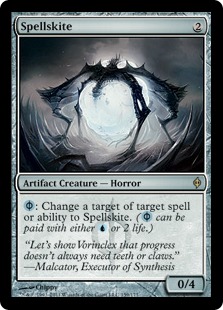 Spellskite
Spellskite
I think this is understood but I want to be clear, there is no deck that plays Spellskite in the sideboard that doesn't also want a copy or two maindeck. If Spellskite is good in your deck, that shouldn't be dependent on your opponent's archetype.
Control and combo decks will sometimes bring Spellskite in against Infect or some combo decks but I maintain that this is wrong. Those archetypes have access to much more powerful and harder-to-answer cards than Spellskite that also can't be played around. Infect knows to play around the card using Wild Defiance, which against control and combo they'd be bringing in anyway either to speed up their clock or protect themselves from Lightning Bolt. Infect also boards in Nature's Claim to force their way through. What's the point of bringing in Spellskite in that scenario? The combo or control deck would be better off with a removal spell that gets around the counter-sideboard cards like Pyroclasm.
If combo decks like Ad Nauseam are your worry then Leyline of Sanctity is not only more powerful but also harder to answer. They tend to play more ways to answer a creature as opposed to other permanents. Players have used Skite against Scapeshift as well, but it's not that burdensome for that deck to simply overwhelm the Skite, which you can't do with Leyline.
As a dedicated hoser, Spellskite is pretty mediocre and easily answered, but as a maindeck card with added benefits it is exceptionally strong. Maindeck it to protect your creatures, and then play an extra copy or two for extra utility in the board.
Pithing Needle
This card does not see enough play. There is not a deck that it doesn't hit and there are many that it cripples. Naming fetchlands is not the worst and sometimes it's absolutely crippling, especially turn one with Gitaxian Probe. It also hits planeswalkers, manlands, Tron, Affinity, Lightning Storm, and Grim Lavamancer. The sheer utility of the card and its potential to be devastatingly effective against so many decks make it a safe and powerful maindeck inclusion if you have space. Not every deck will have the space for it, but any deck can run it and have it be effective. If you're looking to maindeck a hate card, I'd start with this one.
Relic of Progenitus
If you're going to maindeck graveyard hate this is the piece to use (I wouldn't consider Scavenging Ooze a sideboard card per se). Graveyard hate is rarely dead in Modern and is very good against many decks. Even when it isn't very effective it does cantrip, and while I don't think that's a reason to play a card by itself, it does make targeted hate more playable.
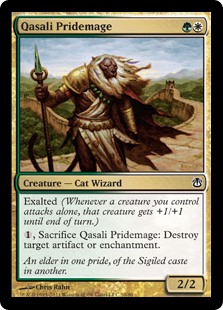 Qasali Pridemage
Qasali Pridemage
This is another card that sits in a lot of sideboards when it should be maindeck. There are much more powerful options for the board, but the flexibility and the fact that it attacks for three make it worthy of maindeck inclusion. Pridemage doesn't shine against any deck or accomplish anything very efficiently compared to other options, which is not what you want from your sideboard cards.
However its flexibility makes it an exceptional maindeck inclusion that also reduces the pressure on your sideboard to answer problematic artifacts or enchantments. If you have it in your board it should only be to bring in extra copies. Having a maindeck out to Worship and Ensnaring Bridge is powerful and not something you want to be without. The same goes for Reclamation Sage and Echoing Truth.
Worship
If you have creatures and are playing a removal-light deck, this card will win you the game. Even against control decks this can threaten to keep them from winning, especially combined with hexproof or indestructible. If you think you'll want it, you'll get quite a few free wins by building around it.
There's Always More to Learn
My list is not even close to exhaustive, but it should give you a jumping off point for considering other cards that currently sit in your sideboards but should be maindeck. Determining what cards you should use and whether a sideboard card should be maindeck is something else entirely, which I won't get into today. Rather, it's going to be included in next week's article, where I'll discuss the strategy known as The Elephant. Until then, if you have questions or other topics you want to discuss, you can always find me in the comments.





I think transformational sideboard and maindeck bullets are lot more common in local metas when you are more certain about matchups you will come across. Some people at our store play several maindeck sweepers exactly because they are good to answer affinity and zoo. There’s also a lot more artifact (again, affinity) and grave (spooky scary Storm) hate in boards.
I myself am considering to include transformational sideboard just because most of the decks I play are combo ones and they fall miserably against said hate and it sucks horribly to lose games that way. Maybe add some Things in The Ice’s and Young Pyros into my Storm and Jeskai Ascendancy board lists?
Storm and Ascendancy are two decks that lend themselves quite well to transformations, and also benefit the most for the reasons you mention. Young Pyromancer is a definite inclusion, but I’m not sold on Thing in the Ice. Yes it’s pretty easy to flip but it’s also more vulnerable than Pyromancer and do you really need it against creature decks? It seems like just racing is your best call in those matchups. I’d transform with Pyromancer, Snapcaster Mage and possibly even Delver before Thing.
There’s another form of Pseudo-transformational boards that’s oddly specific in modern, but it’s worth mentioning:
Gifts Ungiven, in every format it’s been a thing in, has lent itself to what I call a “progressive transformational sideboard”. What I mean by that is that the nature of the namesake card means the deck has the capability to transform to varying degrees–a well constructed sideboard can allow you the freedom within a single match to alter your gifts piles, double down on a combo gameplan, or to cut gifts and its support cards entirely in favor of a more midrange gameplan. Not recently, but a year and a half ago or so we were seeing some 4c gifts builds on stream that had a sideboard plan on the play of doubling down on reanimating iona or elesh norn or something, and a sideboard plan on the draw of cutting gifts entirely in favor of a straight up midrange-style game plan. It’s not common to see, but most formats at one time or another have decks for which this is possible.
In Vintage, you had a period of time where TES decks could sidestep into an awkward version of shops to completely dodge the hate that drain decks would bring in. In legacy, you have the RG lands deck today, which can double down on being a combo deck with some backup primeval titans, or it can go the full prison route with sphere of resistance and chalice of the void/trinisphere, sometimes within the same matchup. In old extended, you had the thopter-depths decks that could sidestep the hate by switching to value gifts piles and removing their reliance on the graveyard entirely in games 2 and 3. In a similar vein, you had the all in red lists that could board into something of a prison shell.
In modern, we have the aforementioned gifts lists, and early on in the format we had UR twin decks playing one or two bolts and 2 or 3 of relevant combo pieces, with sideboards that could range from moving all in on the combo to cutting it almost entirely.
In standard, we’ve had the old bolt-warp decks that could transform into a value-based midrangy burn deck or even cut the pyromancer ascension entirely in favor of some creatures, rendering them an awkward but effective tempo deck with time warp effects to play once their threats were online. More recently, we had the mono blue devotion decks, that could end up anywhere on the spectrum from a dedicated tempo deck against UW elixir, to attempts to straight up beat them at the control game.
This general piece of sideboarding strategy, having a fluid way to either transform entirely along a spectrum with respect to ONE OR TWO COMMON MATCHUPS is a trait that I think many experienced players miss–if a matchup is common, you can snipe a lot of percentage points by having a variety of ways to sideboard for the matchup. The most recent one I can think of? UR twin mirrors just before twin got banned–the assumption was that players would be more controlling and light on the combo in sideboarded games, but we all know there were times on camera where one player took a gamble and went all in on the combo in sideboard games, turning the matchup into a shell game to either devastating or comical effect.